The Saucony Kinvara has long been a go-to for runners who value lightweight flexibility and a natural ride. Now on its 16th iteration, the Kinvara continues to evolve without losing its minimalist DNA.
For 2025, the Saucony Kinvara 16 brings subtle but meaningful updates. The PWRRUN midsole feels a touch more responsive than before, part of Saucony’s steady improvement in energy return across recent Kinvara models. Meanwhile, the upper offers better midfoot support without sacrificing that barely-there, second-skin fit fans love. No hot spots, no fuss.
This shoe isn’t trying to be everything for everyone. It’s made for experienced runners who want a flexible, smooth-rolling trainer that lets their stride do the work. Whether you’re logging daily miles or picking up the pace, the Kinvara 16 delivers a no-nonsense, natural feel that’s built for movement.
Table of Contents
- Design and Fit
- Midsole and Cushioning
- Outsole and Traction
- Performance on the Run
- Pros and Cons
- Who Should (and Shouldn’t) Buy the Saucony Kinvara 16
- Final Verdict: Saucony Kinvara 16
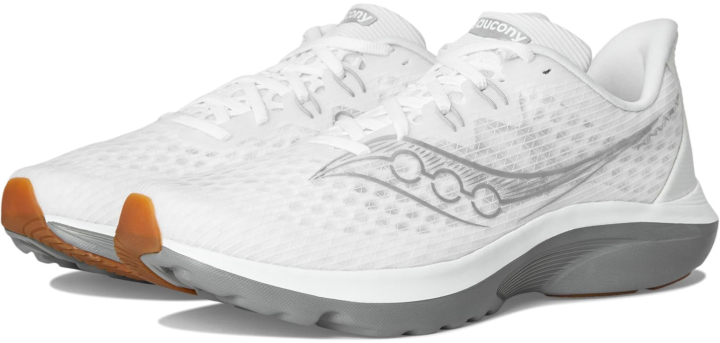
Design and Fit
The Saucony Kinvara 16 sticks to its streamlined roots, but with a few updates. The engineered mesh upper allows for decent airflow, keeping your feet cool during most runs. That said, it’s not the most breathable option out there on hotter days, things can get a little warm.
This version is slightly heavier than the Kinvara 15, adding 2.8 grams for women and 8.5 grams for men, making the new weight 6.3 oz for women and 7.3 oz for men. The difference is minor, but worth noting for weight-conscious runners. Fit-wise, it runs true to size with a comfortable amount of room in the toe box. The upper wraps the foot securely, delivering a snug fit through the midfoot without feeling restrictive. Overall, it strikes a solid balance between comfort and lockdown.
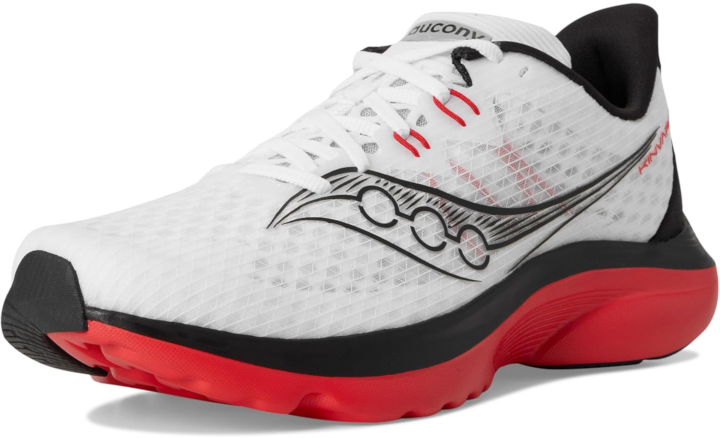
Midsole and Cushioning
The Saucony Kinvara 16 features an updated PWRRUN midsole that focuses on comfort, support, and day-to-day reliability. According to Saucony, this version delivers 3% better rebound than the previous model; a small but welcome bump in responsiveness for fans of the Kinvara line.
The stack height drops slightly to 28 mm in the heel and 24 mm in the forefoot, keeping the familiar 4 mm heel-to-toe drop. Despite the lower profile, the ride feels natural and fluid, with enough cushioning to handle daily training without losing that signature Kinvara ground feel.
There’s no carbon plate or aggressive rocker here; just a flexible platform that encourages your foot to do the work. It’s the kind of shoe that lets you feel connected to the road while helping you build strength and form with every stride.
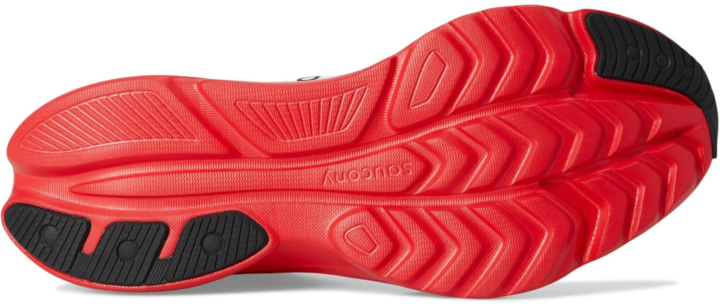
Outsole and Traction
The Saucony Kinvara 16 keeps things minimal on the outsole. There’s less rubber coverage overall, but it’s strategically placed in high-wear areas to balance weight and durability. While this setup works well for most surfaces, you’ll want to watch your step on slick or wet roads; grip isn’t its strong suit in those conditions.
The exposed EVA foam underneath is tough enough for daily mileage, but it won’t outlast the rubber patches. That said, traction feels solid on dry pavement, treadmills, and even light gravel.
Where the Kinvara 16 really shines is in its flexibility. The outsole bends naturally with your stride, allowing your foot to move freely. This barefoot-adjacent feel is exactly why so many runners keep coming back to the Kinvara year after year.
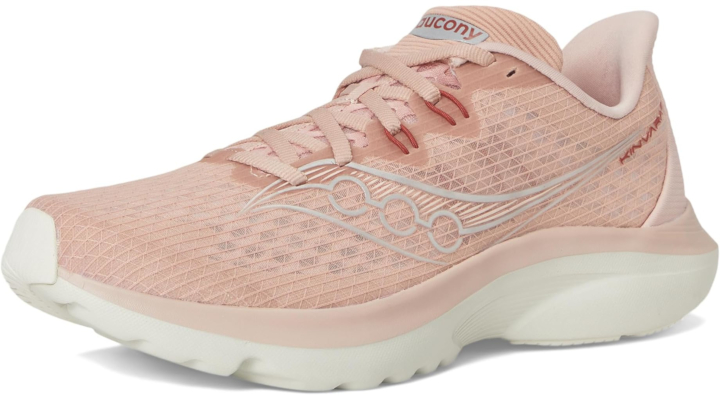
Performance on the Run
The Saucony Kinvara 16 isn’t built for beginners. With its lower stack height and minimal structure, it’s better suited for experienced runners who want to fine-tune their form and strengthen their lower legs. This shoe rewards good mechanics—and expects your muscles to do the work.
While it can handle race day in a pinch, the Kinvara 16 feels most at home on tempo runs. It’s light, quick, and nimble, one of the lightest shoes in Saucony’s lineup, but surprisingly stable. That stability comes from the firmer PWRRUN foam, supportive sidewalls, and a dialed-in lockdown that keeps your foot secure at any pace.
Performance-wise, it feels similar to the Kinvara 15, but the updated design leans more toward race-day aesthetics. It may look fast, but underfoot it’s still a no-frills, do-it-yourself kind of ride that rewards runners who like to stay connected to the ground.
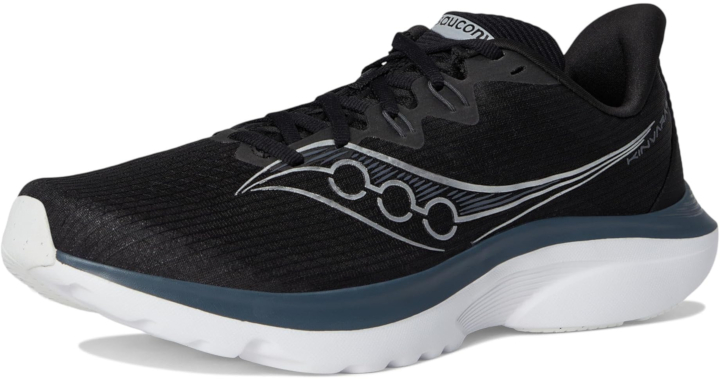
Pros and Cons
Pros:
- Lightweight and flexible: One of the lightest Saucony trainers with excellent ground feel.
- Updated PWRRUN midsole: Slightly more responsive with improved rebound for faster efforts.
- Natural ride: Promotes foot strength and better running form without plates or aggressive geometry.
- Snug, supportive upper: Second skin fit with no hot spots and solid midfoot lockdown.
- Surprisingly stable: Firmer foam and high sidewalls offer stability despite the minimal build.
Cons:
- Not ideal for beginners: Lower stack height and minimal cushioning require stronger form and mechanics.
- Limited outsole rubber: Traction on wet surfaces can be sketchy; durability may be a concern.
- Warm in hot weather: Breathability is decent, but not great in high-heat conditions.
- Lacks propulsion features: No rocker or carbon plate to help with forward momentum—everything depends on you (plus, the responsiveness of the midsole foam).
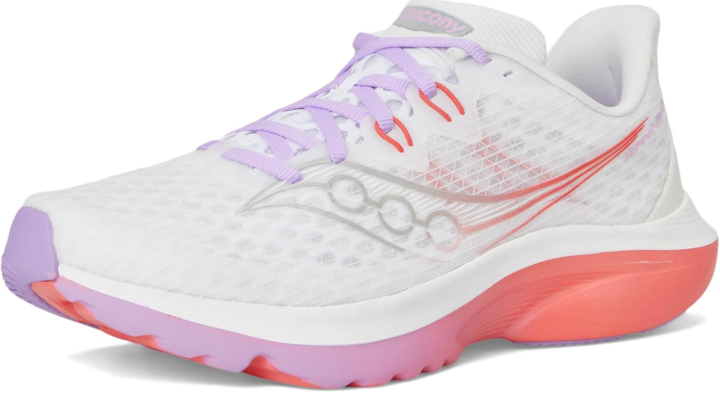
Who Should (and Shouldn’t) Buy the Saucony Kinvara 16
You should buy the Saucony Kinvara 16 if:
- You’re an experienced runner who prefers a lightweight, flexible trainer.
- You want a shoe that encourages natural movement and helps build lower leg strength.
- You enjoy tempo runs or want a minimal race-day option without a carbon plate.
- You value ground feel and responsiveness over plush cushioning.
- You’ve loved past Kinvaras and want a familiar ride with slightly snappier rebound.
You should skip the Saucony Kinvara 16 if:
- You’re a beginner who needs more cushioning or support.
- You regularly run on wet or slick surfaces and need reliable traction.
- You prefer max-cushion or rocker-style shoes that assist with forward propulsion.
- You’re looking for a long-distance trainer with high durability and comfort over many miles.
Final Verdict: Saucony Kinvara 16
The Saucony Kinvara 16 stays true to its roots—light, flexible, and built for runners who like to do the work themselves. With a slightly more responsive PWRRUN midsole and a snug, supportive upper, this version refines the Kinvara formula without changing its core identity.
It’s not a max-cushion cruiser or a high-tech speed shoe. But if you’re an experienced runner looking for a natural-feeling trainer that strengthens form and rewards effort, the Kinvara 16 delivers. It’s simple, stable, and dependable; proof that sometimes, less really is more.
Disclosure: This page has affiliate links, so if you click and buy something, we might earn a tiny commission at no extra cost to you. It’s like giving us a virtual high-five while you shop. Win-win, right?
You may also like:

